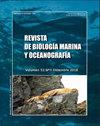Spatial and temporal distribution of sea turtles related to sea surface temperature and chlorophyll-a in Mexican Central Pacific waters
IF 0.5
4区 生物学
Q4 MARINE & FRESHWATER BIOLOGY
引用次数: 9
Abstract
espanolEn este estudio se describe la distribucion espacio-temporal de tortugas marinas y su relacion con parametros oceanograficos en el Pacifico Central Mexicano (PCM) durante el 2010 (invierno, primavera y otono). Los resultados muestran variaciones en la distribucion de tortugas marinas. En invierno, la distribucion de tortugas fue homogenea en areas costeras y oceanicas; asociadas a la presencia de frentes termicos debido a la interaccion de una corriente de agua calida del sur y la intrusion de agua fria proveniente del noroeste, asi como con los limites de un giro ciclonico. En primavera, la distribucion de tortugas se concentro hacia la zona costera y parte central de la zona oceanica, donde prevalecieron los efectos de una surgencia y los limites de un giro ciclonico. El mismo patron de distribucion ocurrio al inicio de otono, mientras que las condiciones oceanograficas cambiaron para la segunda semana de muestreo, cuando ocurrio la formacion de una surgencia costera. Los eventos de apareamiento solo se registraron durante otono para la tortuga golfina (Lepidochelys olivacea), la especie dominante de la region. Se concluye que en otono el patron de distribucion de tortugas marinas fue hacia la zona costera del PCM, y se relaciono con actividades de reproduccion; mientras que en invierno y primavera este patron tendio a la region central/oceanica vinculado potencialmente con actividades de forrajeo. EnglishIn this study we describe the spatial and temporal distribution of sea turtles and their association with oceanographic parameters in waters of the Mexican Central Pacific (MCP) during 2010 (winter, spring and autumn). Our results showed variations in sea turtle distribution through the sampling year. Sea turtle distribution was homogeneous in coastal and oceanic areas during winter; there was an association with thermal fronts generated by a current of cold water flowing from the northwest and a warm current coming from the south, as well as with the boundaries of a cyclonic gyre. Sea turtles were distributed in the coastal zone and the central part of the oceanic zone in spring, where the effects of a cyclonic gyre and coastal upwelling prevailed. The same distribution trend was recorded at the beginning of autumn, whereas oceanographic characteristics changed during the second sampling week, when upwelling occurred. Mating events were only recorded in autumn for olive ridley sea turtles (Lepidochelys olivacea), the dominant species in the region. It was concluded that sea turtles were distributed in the coastal zone of MCP waters in autumn due to reproductive activities, whereas in winter and spring sea turtles were distributed towards the central/oceanic region, potentially related to foraging activities.墨西哥中太平洋海域海龟时空分布与海表温度和叶绿素-a的关系
本研究描述了2010年墨西哥中太平洋(PCM)海龟的时空分布及其与海洋参数的关系。本研究的目的是确定海龟种群中海龟的分布。在冬季,海龟在沿海和海洋地区分布均匀;与热锋的存在有关,这是由于来自南方的暖流和来自西北的冷水侵入的相互作用,以及气旋旋回的限制。在春季,海龟的分布集中在沿海和海洋带的中部,那里的上升流的影响和气旋环流的限制占主导地位。在第一个采样周,当海岸上升流形成时,海洋条件发生了变化。该地区的优势物种——橄榄龟(Lepidochelys olivacea)仅在秋季记录了交配事件。结果表明,海龟的分布模式向PCM沿海地区移动,与繁殖活动有关;而在冬季和春季,这种模式倾向于中部/大洋洲地区,可能与觅食活动有关。在本研究中,我们描述了2010年(冬季、春季和秋季)墨西哥中太平洋水域海龟的时空分布及其与海洋参数的关系。= =地理= =根据美国人口普查局的数据,cdp的总面积为,其中土地和(1.6%)水。冬季海龟在沿海和海洋地区分布均匀;= =地理= =根据美国人口普查,这个县的面积为,其中土地面积为,其中土地面积为。= =地理= =根据美国人口普查,这个县的总面积为,其中土地和(2.641平方公里)水。= =地理= =根据美国人口普查,该地区的总面积为,其中土地和(2.641平方公里)水。= =地理= =根据美国人口普查,这个县的总面积为,其中土地和(2.641平方公里)水。结论是,由于繁殖活动,海龟在秋季分布在MCP水域的沿海地带,而在冬季和春季,海龟分布在中部/海洋区域,可能与觅食活动有关。
本文章由计算机程序翻译,如有差异,请以英文原文为准。
求助全文
约1分钟内获得全文
求助全文
来源期刊
CiteScore
0.70
自引率
0.00%
发文量
41
审稿时长
12 months
期刊介绍:
Publicar desde una perspectiva científica, artículos originales, decididos por un proceso de revisión por pares, invitando a expertos de reconocido prestigio en el área. Los trabajos publicados se caracterizarán por su solidez teórica-metodológica, actualidad y relevancia para las ciencias marinas.
Se reciben trabajos inéditos derivados de la investigación científica realizada en ambientes marinos y estuarios, en formato de Revisión, Artículos, Notas Científicas, y Obituarios en las siguientes disciplinas::
Biología-Ecología marina
Oceanografía física, química y biológica
Contaminación marina
Geología marina
Sistemática, Faunística y Biogeografía Marina
Manejo Costero
Acuicultura marina
Pesquería marina.

 求助内容:
求助内容: 应助结果提醒方式:
应助结果提醒方式:


